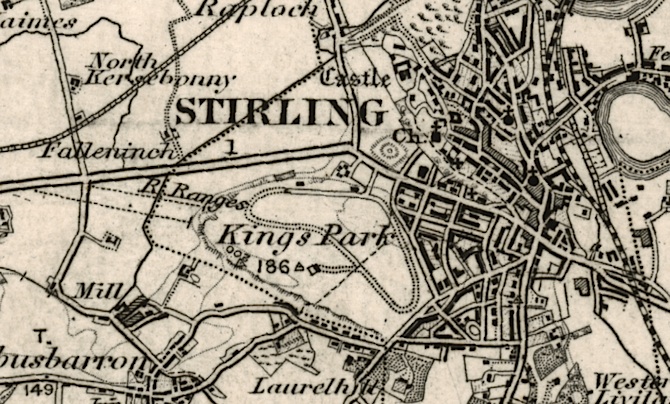High Noon for King’s Park

On Thursday this week, Stirling Councillors meet to decide the fate of the King’s Park (item 19 on agenda). This is the first time the new Council has the opportunity to consider the plans developed by the last council. For a critique of these see this post and for background documents see here.
Since then, the historic importance of the site has been affirmed by a group of leading historians including the Historiographer Royal, Professor Chris Smout. The UK government has also responded to the recommendations of the Scottish Affairs Committee report (see quoted extracts here) and ruled out the transfer on the flimsiest of grounds. In its report of 10 July 2012, it claims at para 7.6 that,
The King’s Park, Stirling cannot, however, be among these. After lengthy negotiations, the Crown Estate recently agreed a market price for its sale to Stirling Council, so transfer at nil cost would be incompatible with the Crown Estate’s statutory responsibilities.
Political dogma and axe grinding obscuring what’s really at stake here.
There are various misunderstandings about the King’s Park. First, only about 20% of it is actually a park – Kings Park and Gowan Hill. These are no doubt nice enough but hardly the jewel in the heritage crown implied by the paper (written, I suspect, by Robin Callander, who lives in Aberdeenshire) bearing the names of the eminent historians. The only bit of actual heritage value, the King’s Knot, already belongs to Historic Scotland.
Most of the rest of the King’s Park – almost 80% of it – is divided between a golf course (not being a golfer, I’m unable to comment on its merits) and pretty ordinary flat farm land (the fields on either side of Dumbarton Road as far as the motorway).
The reason why the KP has a value is NOT because the Council offered to buy an otherwise worthless item as Andy states. It’s because the KP carries a valuable income stream, namely, the rents paid by the golf club and the tenant farmer. I believe the Council also rents the parks and I gather there are two let houses as well. Even if the Council withdrew its offer, the KP would still have a value based on that rental stream. The matter is set out very succinctly by Alan Laidlaw of the Crown Estate in his letter of 25 September 2012 which is included amongst the Council’s agenda papers which Andy links to.
Hence, there can be no question of the Crown Estate just giving this income producing asset away to Historic Scotland (or anyone else) unless/until ordered to so by its political masters, namely the UK Government which has already said no for perfectly intelligible reasons.
It is the value represented by its income stream which distinguishes KP from the other properties the CE has given to Historic Scotland in the past (Linlithgow Palace etc.) – the latter have no value, in fact are net liabilities considering the costs of keeping them in repair.
Thus, the *only* question for the Council tomorrow is whether the price represents a good investment for the cash reserves held by the common good fund. I’m not qualified to judge that but if the advice from those who are is that it *is* a good investment, then if the Council withdraws its offer in the misguided hope that the CE will thereupon perform a volte face and donate the KP to HS, then I would suggest the Council would be guilty of the sort of maladministration of the common good fund that Andy is always railing against.
Only two other things I’d add – which are arguably in conflict with the foregoing – (1) I’d be reluctant to see the park going to the common good for fear of repeating the Portobello Park fiasco whereby NIMBYs could seize on outdated laws to prevent a change of use in the future. To avoid that, it would be better IMO, if the freehold of the parks could be acquired in the exercise of appropriate statutory powers in that regard; (2) if we are going to be political, would it not be more politically correct to sell the farm land element to the tenant farmer?